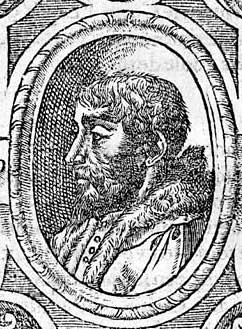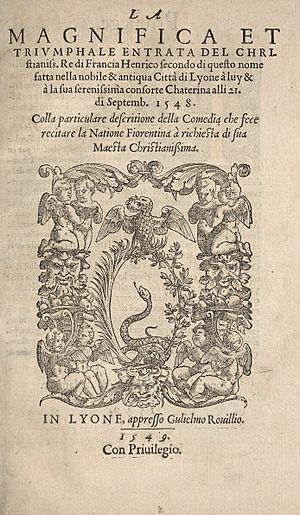Maurice Scève facts for kids
Maurice Scève (born around 1501, died around 1564) was an important French poet. He lived in the city of Lyon during the Renaissance period. This was a time of great new ideas in art and learning.
Scève was a leader of a group of writers in Lyon. They explored ideas about spiritual love, inspired by ancient Greek philosopher Plato and the Italian poet Petrarch.
His most famous work is Délie, objet de plus haulte vertu (1544). He also wrote short poems called blasons and a long poem called Microcosme (1562). Even though some of his poems were seen as hard to understand, other famous poets praised him. They said he helped make French poetry better. The exact date of his death is not known, but it was after 1560.
Contents
Life of Maurice Scève
Maurice Scève was likely born in 1501. His father was a lawyer and city official in Lyon. His father even served as Lyon's ambassador to the court of King François I. This gave Scève's family a good standing in the city.
Scève was the leader of a group of writers in Lyon. This group included his friend Claude de Taillemont and the doctor Pierre Tolet. It also had many women writers like Pernette du Guillet, Louise Labé, and Scève's own sisters, Claudine and Sybille Scève.
Maurice Scève's Works
Scève first became known as a poet in 1535. He sent two poems called blasons to another poet, Clément Marot. These poems were Le Sourcil ("The Eyebrow") and La Larme ("The Tear").
He sent them for a poetry contest that Marot organized. Le Sourcil was chosen as the winner. This made Scève famous in France and Italy. These poems were published in 1536. More of his blasons were published later in 1539.
Délie: A Famous Collection
Délie is Scève's most famous work. It is a collection of 449 ten-line poems called dizains. It starts with an eight-line poem dedicated to his beloved, "A sa Délie."
Some people think the title Délie is a secret way of saying l'idée, which means "the idea." This collection was the first French "canzoniere." This type of poetry collection was inspired by Petrarch's very popular Canzoniere, which was a series of love poems.
Scève also translated a sad novel called Grimalte y Gradissa from Spanish. It was published in 1535 as La Déplorable fin de Flamète. This story was inspired by the writer Giovanni Boccaccio.
Maurice Scève was also a talented musician. He cared a lot about how his words sounded in his poems. Because of his musical skill and his deep knowledge, he helped connect the style of Marot's poetry with the later group of poets called the Pléiade.
Selected Works
English Translations
- Emblems of Desire: Selections from the "Délie" of Maurice Scève, translated by Richard Sieburth. (University of Pennsylvania Press, 2002) ISBN: 0-8122-3694-7
See also
 In Spanish: Maurice Scève para niños
In Spanish: Maurice Scève para niños



